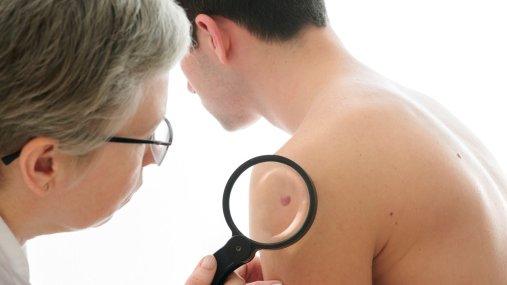Skin cancer cases double in 30 years but survival rates also rise
- Published

The study says more affordable foreign holidays, sunbeds and the ageing population was contributing to the increase in skin cancer but better sun protection and earlier detection had led to better survival
Skin cancer cases have increased two-and-a-half fold over the last 30 years but survival rates have also soared, according to researchers from Glasgow.
Researchers from the Alan Lyell Centre for Dermatology in Glasgow found a significant rise in cases since 1990.
But they also noted that 85% per cent of men and 90% of women now survive for at least five years after diagnosis.
Between 1983 and 1987, survival at five years after diagnosis was just 64% for men and 81.9% for women.
The authors said better sun protection and earlier detection had led to better survival rates.
However, more affordable foreign holidays, sunbeds and an ageing population was contributing to an increase in skin cancer.
The study is being presented this week at the World Congress of Cancers of the Skin in Edinburgh.
The academics analysed data from the Information Services Division Scotland on Scottish skin cancer cases since 1990.
It showed that between 2009 and 2010 there was a 1% fall in the incidence rate for skin cancer, however this subsequently increased in 2011, above the previous highest recording.
There are three main types of skin cancer. Melanoma is the least common but most deadly form.
'Pale skin'
Squamous cell carcinoma is the second most common type, and together with basal cell carcinoma - the most common but least dangerous form - is known as non-melanoma skin cancer.
Melanoma, the most deadly, increased from 495 cases in 1990 to 1,202 cases in 2011.
Basal cell carcinoma rose from 2,910 cases in 1990, to 7,553 cases in 2011.
And squamous cell carcinoma rose from 892 cases in 1990, to 2,982 cases in 2011.
Dr Gregory Parkins, one of the authors of the study, said: "It will come as no surprise to the people of Scotland that a large proportion of us have pale skin, which makes the risk of developing skin cancer higher. This means that education around skin cancer and sun protection is hugely important."
Matthew Gass of the British Association of Dermatologists said: "The incidence of melanoma and non-melanoma skin cancer continues to rise at a worrying rate, and although the rise in incidence has been met by an improvement in survival rates, the ultimate goal is to prevent skin cancers occurring in the first place.
"There is still a long way to go in terms of education around sun awareness and skin cancer. We hope that people recognise that prevention is far better than a cure."
- Published31 August 2014

- Published21 April 2014

- Published13 April 2014

- Published30 March 2014

- Published21 August 2013
